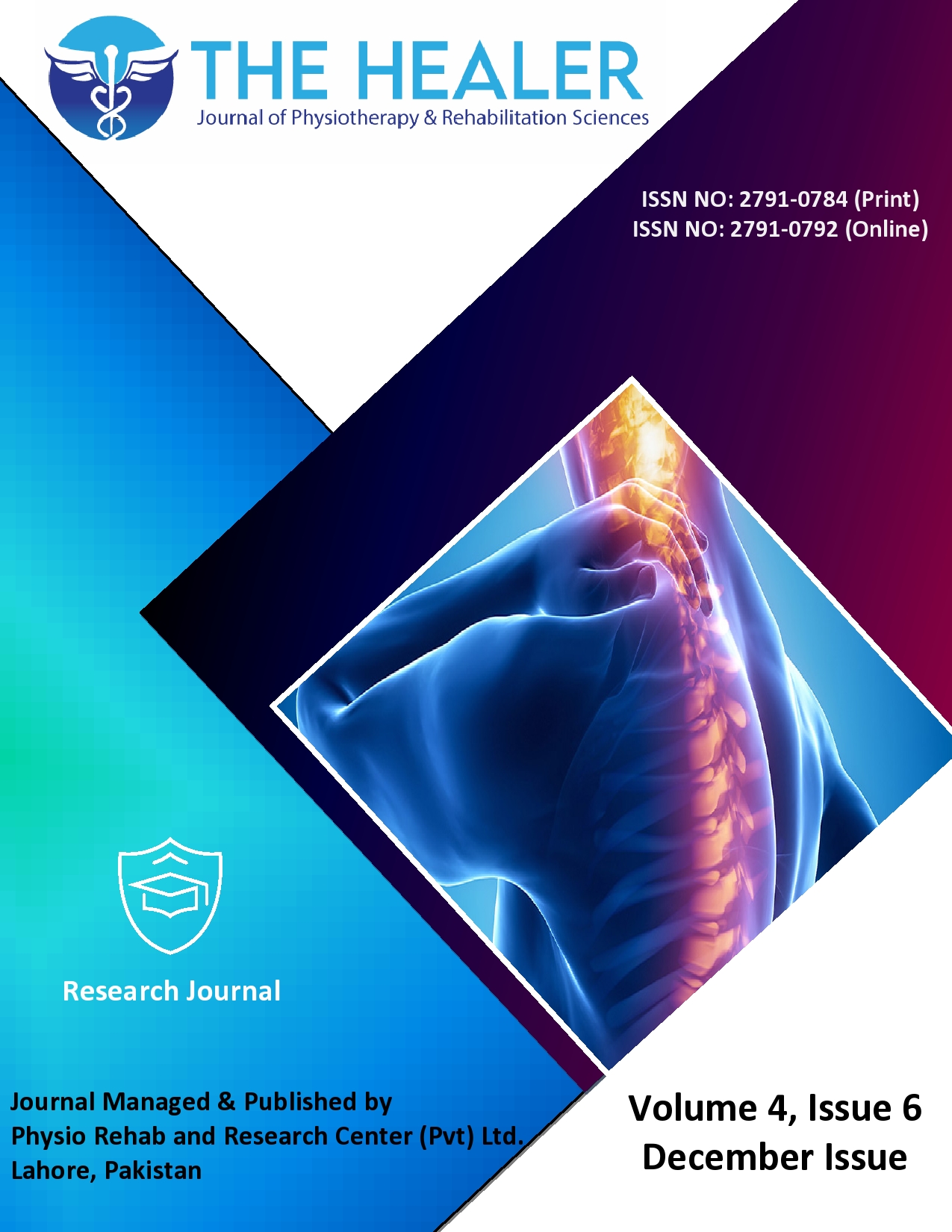Efficacy of Femoral Nerve Block Compared to Adductor Canal Block for Post Operative Pain Management After Total Knee Arthroplasty
Femoral Nerve vs Adductor Canal Block After Total Knee Arthroplasty
DOI:
https://doi.org/10.55735/hjprs.v4i6.297Keywords:
Adductor canal block , Femoral nerve block , Numeric rating scale , Postoperative pain, Straight leg raise, Total knee arthroplastyAbstract
Background: After total knee arthroplasty, regional anaesthetic methods such as femoral nerve and adductor canal blocks are frequently used to ease the pain. Objective: To assess how femoral nerve and adductor canal blocks affect post-operative mobility, healing time, and pain management following total knee arthroplasty. Methodology: From October 8, 2023, to September 25, 2024, a tertiary care hospital hosted this cross-sectional study. We randomly assigned 160 patients receiving unilateral primary total knee replacement to either the adductor canal or femoral nerve block (80 in each group). Before surgery, each group had their nerve block. Postoperative pain was measured at 6, 12, 18, and 24 hours using the numeric rating scale. Mobility on postoperative days 1–7 and the time until straight leg raise were recovery markers. Results: Age (femoral nerve block: 65.4±8.3 years; ACB: 64.8±7.9 years), gender distribution, body mass index, and ASA physical state did not significantly differ across groups. At every time point, the femoral nerve block group's pain scores were significantly lower: at 6 hours, this score was 3.8±1.2, compared to the adductor canal block's 4.2±1.3 (p=0.04). These tendencies continued at later evaluations (p<0.03). About 35% of the femoral nerve block group and 67.5% of the ACB group, respectively, attained straight leg raise greater than 30° on Day 1 (p<0.001). By Day 7, 93.75% of the femoral nerve block group and 100% of the ACB group had pain-free straight leg raise (p=0.05). According to multiple regression analysis, femoral nerve block was substantially linked to quicker recovery and lower pain scores (B=-0.5, p=0.001). Conclusion: After total knee arthroplasty, femoral nerve block provides better postoperative pain management and a faster recovery than adductor canal block, although adductor canal block allows for earlier leg mobilization and improves straight leg raise recovery.
Downloads
References
View of A comparative study between ultrasound-guided four-in-one block vs. femoral
nerve block vs. adductor canal block to enhance recovery after knee replacement surgery | Anaesthesia, Pain & Intensive Care [Internet]. [cited 2024 Nov 19]. Available from: https://www.apicareonline.com/index.php/APIC/article/view/1834/2749
JT Wegener BOCDMHBPMS. Value of single-injection or continuous sciatic nerve block in addition to a continuous femoral nerve block in patients undergoing total knee arthroplasty: a prospective, randomized, controlled trial. Reg Anesth Pain Med. 2011;36:481–8. DOI: https://doi.org/10.1097/AAP.0b013e318228c33a
DH Kim Y. Adductor canal block versus femoral nerve block for total knee arthroplasty: a prospective, randomized, controlled trial. Anesthesiology. 2014;120:540–50. DOI: https://doi.org/10.1097/ALN.0000000000000119
Gao F, Ma J, Sun W, Guo W, Li Z, Wang W. Adductor Canal Block Versus Femoral Nerve Block for Analgesia After Total Knee Arthroplasty: A Systematic Review and Meta-analysis. Clin J Pain [Internet]. 2017 [cited 2024 Dec 1];33(4):356–68. Available from: https://pubmed.ncbi.nlm.nih.gov/27322397/ DOI: https://doi.org/10.1097/AJP.0000000000000402
A Randomized Study of the Effectiveness of Suprascapular Nerve Block in Patient Satisfaction and Outcome After Arthroscopic Subacromial Decompression - ScienceDirect [Internet]. [cited 2024 Nov 25]. Available from: https://www.sciencedirect.com/science/article/abs/pii/S0749806311005299
Koh IJ, Chang CB, Lee JH, Jeon YT, Kim TK. Preemptive low-dose dexamethasone reduces postoperative emesis and pain after TKA: A randomized controlled study. Clin Orthop Relat Res. 2013;471(9):3010–20. DOI: https://doi.org/10.1007/s11999-013-3032-5
BM Ilfeld KDMD. The association between lower extremity continuous peripheral nerve blocks and patient falls after knee and hip arthroplasty. Anesth Analg. 2010;111:1552–4. DOI: https://doi.org/10.1213/ANE.0b013e3181fb9507
AM Morin L. Does femoral nerve catheter placement with stimulating catheters improve effective placement? A randomized, controlled, and observer-blinded trial. Anesth Analg. 2005;100(5):1503–10. DOI: https://doi.org/10.1213/01.ANE.0000151160.93288.0A
ME Patterson K. The adductor canal block provides effective analgesia similar to a femoral nerve block in patients undergoing total knee arthroplasty-a retrospective study. J Clin Anesth. 2014; DOI: https://doi.org/10.1016/j.jclinane.2014.08.005
H Wulf JLKHGTS. Femoral nerve block with ropivacaine or bupivacaine in day case anterior crucial ligament reconstruction. Acta Anaesthesiol Scand. 2010;54:414–20. DOI: https://doi.org/10.1111/j.1399-6576.2009.02200.x
T Wiesmann TSGWHWJSMZ. Supplemental single shot femoral nerve block for total hip arthroplasty—impact on early postoperative care, pain management and lung function. Minerva Anestesiol. 2014;80(1):48–57.
E-Y Chan MFDPPANC. Femoral nerve blocks for acute postoperative pain after knee replacement surgery. Cochrane Database Syst Rev. 2014;5:CD009941. DOI: https://doi.org/10.1002/14651858.CD009941.pub2
SG Memtsoudis D. Subsartorial adductor canal vs femoral nerve block for analgesia after total knee replacement. Int Orthop. 2014; DOI: https://doi.org/10.1007/s00264-014-2527-3
JP Benthien DH. Efficacy of continuous catheter analgesia of the sciatic nerve after total knee arthroplasty. Swiss Med Wkly. 2015;145:w14119. DOI: https://doi.org/10.4414/smw.2015.14119
U Grevstad OMLVPJKHJD. Effect of adductor canal block versus femoral nerve block on quadriceps strength, mobilization, and pain after total knee arthroplasty. Reg Anesth Pain Med. 2015;40:3–10. DOI: https://doi.org/10.1097/AAP.0000000000000169
RL Mizner SPLSM. Quadriceps strength and the time course of functional recovery after total knee arthroplasty. J Orthop Sports Phys Ther. 2005;35:424–36. DOI: https://doi.org/10.2519/jospt.2005.35.7.424
K Sato Tansnn. Continuous versus single-injection sciatic nerve block added to continuous femoral nerve block for analgesia after total knee arthroplasty: a prospective, randomized, double-blind study. Reg Anesth Pain Med. 2014;39:225–9. DOI: https://doi.org/10.1097/AAP.0000000000000076
MT Jenstrup PJJLJFSBOMTLJD. Effects of adductor-canal-blockade on pain and ambulation after total knee arthroplasty: a randomized study. Acta Anaesthesiol Scand. 2012;56:357–64. DOI: https://doi.org/10.1111/j.1399-6576.2011.02621.x
Ilfeld B. Continuous peripheral nerve blocks: a review of the published evidence. Anesth Analg. 2011;113:904–25. DOI: https://doi.org/10.1213/ANE.0b013e3182285e01
NB Foss MKHK. Prediction of postoperative morbidity, mortality and rehabilitation in hip fracture patients: the cumulated ambulation score. Clin Rehabil. 2006;20:701–8. DOI: https://doi.org/10.1191/0269215506cre987oa
P Jaeger DZJFKHJBJGOMTLJD. Adductor canal block versus femoral nerve block for analgesia after total knee arthroplasty: a randomized, double-blind study. Reg Anesth Pain Med. 2013;38:526–32. DOI: https://doi.org/10.1097/AAP.0000000000000015
BM Ilfeld SM. The sciatic nerve and knee arthroplasty: to block, or not to block—that is the question. Reg Anesth Pain Med. 2011;36:421–3. DOI: https://doi.org/10.1097/AAP.0b013e31822940d2
Wiesmann T, Piechowiak K, Duderstadt S, Haupt D, Schmitt J, Eschbach D, et al. Continuous adductor canal block versus continuous femoral nerve block after total knee arthroplasty for mobilisation capability and pain treatment: a randomised and blinded clinical trial. Archives of Orthopaedic and Trauma Surgery 2016 136:3 [Internet]. 2016 Jan 11 [cited 2024 Nov 19];136(3):397–406. Available from: https://link.springer.com/article/10.1007/s00402-015-2403-7
D Wasserstein CFRBNMRG. Advanced age, obesity and continuous femoral nerve blockade are independent risk factors for inpatient falls after primary total knee arthroplasty. J Arthroplasty. 2013;28:1121–4. DOI: https://doi.org/10.1016/j.arth.2012.08.018
Wiesmann T, Piechowiak K, Duderstadt S, Haupt D, Schmitt J, Eschbach D, et al. Continuous adductor canal block versus continuous femoral nerve block after total knee arthroplasty for mobilisation capability and pain treatment: a randomised and blinded clinical trial. Arch Orthop Trauma Surg [Internet]. 2016 Mar 1 [cited 2024 Nov 19];136(3):397–406. Available from: https://pubmed.ncbi.nlm.nih.gov/26754752/ DOI: https://doi.org/10.1007/s00402-015-2403-7
Continuous adductor canal block versus continuous femoral nerve block after total knee arthroplasty for mobilisation capability and pain treatment: a randomised and blinded clinical trial - PubMed [Internet]. [cited 2024 Nov 19]. Available from: https://pubmed.ncbi.nlm.nih.gov/26754752/
Kwofie MK, Shastri UD, Gadsden JC, Sinha SK, Abrams JH, Xu D, et al. The effects of ultrasound-guided adductor canal block versus femoral nerve block on quadriceps strength and fall risk: A blinded, randomized trial of volunteers. Reg Anesth Pain Med. 2013 Jul;38(4):321–5. DOI: https://doi.org/10.1097/AAP.0b013e318295df80
Adductor canal block versus femoral nerve block for pain control after total knee arthroplasty: A systematic review and Meta-analysis - PMC [Internet]. [cited 2024 Nov 19]. Available from: https://pmc.ncbi.nlm.nih.gov/articles/PMC9410636/#ref-list1
Ardon AE, Clendenen SR, Porter SB, Robards CB, Greengrass RA. Opioid consumption in total knee arthroplasty patients: A retrospective comparison of adductor canal and femoral nerve continuous infusions in the presence of a sciatic nerve catheter. J Clin Anesth. 2016 Jun 1;31:19–26. DOI: https://doi.org/10.1016/j.jclinane.2015.12.014
Kukreja P, Bevinetto C, Brooks B, McKissack H, Montgomery TP, Alexander B, et al. Comparison of Adductor Canal Block and Femoral Nerve Block for Early Ambulation After Primary Total Knee Arthroplasty: A Randomized Controlled Trial. Cureus. 2019 Dec 9. DOI: https://doi.org/10.7759/cureus.6331

Downloads
Published
License
Copyright (c) 2025 The Healer Journal of Physiotherapy and Rehabilitation Sciences

This work is licensed under a Creative Commons Attribution 4.0 International License.














